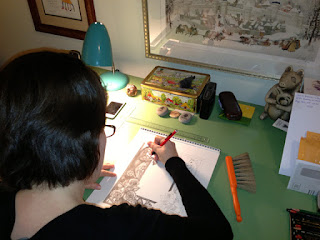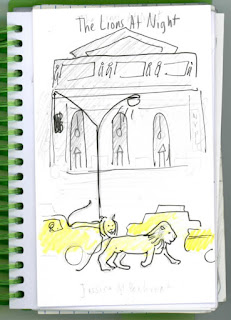I am very excited to introduce Jessica Boehman and her beautiful debut picture book, THE LIONS AT NIGHT. A wordless book, this homage to New York City starts at the New York Public Library on 42nd Street with the famous two lions that "live" by the front entrance. Growing up, Jessica lived in many places in the US and abroad. With fresh eyes, she has found the perfect way to show off her adopted city. When she moved to New York, she took classes at the School of Visual Arts, setting her on her path to become a published author and illustrator. I hope you will be inspired by her journey!
How did THE LIONS AT NIGHT get started? What were some the stages?
How did THE LIONS AT NIGHT get started? What were some the stages?
I came up with this idea as a non-New Yorker living in the city. I’ve been told that I do not have the characteristic cool in the face of the strange that comes from being born and raised in the cacophony of the city. Perhaps I notice too much. One thing that always struck me was that it didn’t matter what weird thing happened on the train: New Yorkers would often keep their eyes ahead, or close them and pretend to sleep, or bury themselves in their book, and pretend not to look. I started to wonder: what would they miss? So I got started with a short two-page wordless comic called “The Lions’ Night Out”. I drew it while convalescing from surgery, when I couldn’t do much more than sit for hours at a time. I don’t know how successful the two-pager was, but the publisher really prodded me to work on this one for my first publication. So I had to change it to a 32-page story. In the end, we added 8 more pages to make it an even 40. I think it needed those extra 38 pages.
So at that point I wrote the script and drew the storyboard. I worked directly from storyboard to full illustrations without a dummy in between, because the publisher had a good sense of the story. I knew I wanted to add a human character, and Mr. Potter, a librarian and caretaker of the lions, came quickly to mind. It changed the tenor of the book from that of the short comic. The comic was just about a sneaky adventure, but the addition of Mr. Potter adds a real element of caring, imagination, and friendship to the mix. I really like him and hope to feature him again in a future book, The Lions in Winter.
Why did you decide to make it a wordless book?
The first two-pager was wordless, and honestly, I wasn’t sure how words were going to add to the story. So I decided to give myself the challenge of telling the story all in pictures. I wanted every kid who came to New York to be able to read it.
What was your favorite part of working on this book?
Even though it felt really difficult, I liked storyboarding the book because I was hashing out lots of ideas and brainstorming. It felt like putting together a puzzle.
And the most difficult part?
The most difficult part was working on the book during the school year. I am a college professor full time at LaGuardia Community College, where I teach primarily Art History, but also the Illustration courses. I would have to start drawing by about 6 am until it was time for breakfast and the shower, and then draw again when I came home. It was exhausting. Moreover, my choice of materials and my particular style made this more time consuming.
The most difficult part was working on the book during the school year. I am a college professor full time at LaGuardia Community College, where I teach primarily Art History, but also the Illustration courses. I would have to start drawing by about 6 am until it was time for breakfast and the shower, and then draw again when I came home. It was exhausting. Moreover, my choice of materials and my particular style made this more time consuming.
Where do you live and what is your studio like? What are your art materials?
I live in Queens, a borough of New York City, in a top-floor apartment with my dog, Ludo. My studio is actually in the foyer of my apartment. I have a desk and a flat file, and lots of art on the walls that inspires me, and clear jars where I divide my pencils by color family to make them easier to find.
All of the drawings, even the greyscale pages, were made with colored pencils, graphite pencils, and gouache. I used digital effects to composite some images, add text and some lighting effects, and clean up smudges. Colored pencil can get quite smeary, so a bit of this digital finagling is sometimes necessary (for me).
What were you like as a child? Have you drawn since you were very young?
I was noisy as a child, but even so, I loved the solitary pursuit of drawing. I spent a lot of time drawing from the time I was little. I remember asking for a sketchbook for a birthday or Christmas present when I was maybe six or seven. My mom bought me a small, grey-covered ringed sketchbook. I still have it. It's filled with marker drawings of superheroes of my own design and pencil sketches of my dog. Though it was the first of many, I will always keep the first evidence of my love of art close to my heart.
It is exciting to hear about each artist's journey to publication. Can you tell us about yours?
It is exciting to hear about each artist's journey to publication. Can you tell us about yours?
I have to admit the way this happened was really unusual. I was taking some time off from pursuing publishers in the wake of a major surgery, and I needed some downtime to heal emotionally and physically, and I was in a major art block. One day, an author wrote to me asking if she could suggest my name to her publisher as a possible pair for her stories, and I said yes. While we have not yet been paired (hopefully someday), the publisher loved my work on my website and wanted to have me get started on my own project first.
What have been some of the ups and downs? Did you have some rejections along the way?
Yes, of course! Well, more than rejections, I got silence. I spent months and months developing my first dummy, and I spent a fortune printing it and mailing it out, only to hear absolutely nothing...from anyone. The worst “down” was when an editor I met in person at a conference told me that she thought my art had no joy in it and I needed to find another creative pursuit. As a professor who works with budding artists, I really disagree with that sort of subjective, destructive feedback. It stopped me in my tracks for a while.
The “ups” have been having a successful online shop where I sell my illustrations and getting regular feedback from customers, meeting my group of supportive and wonderful illustrator friends, and feeling like I’ve found my full self again after many years away from art due to grad school. This was a gradual process, but starting the class with Monica at SVA got me on the right track, and I am really thankful for that. It’s so fun being with like-minded people who are working toward the same goal. When I moved to New York City, I never imagined that I would be here. It’s all been happening one slow step at a time, and I still can’t really believe it.
Is there anything you learned back in class at SVA that has particularly stayed with you?
I learned enough at SVA to be able to teach two illustration classes—a beginning class and a Graphic Narrative class, where we focus on sequential narrative illustration. Some staying lessons: don’t get too attached to a story or a first draft (it might be terrible), learn to accept feedback gracefully (this can be hard), try to draw regularly, and don’t spend all your energy at the storyboard phase. Loose sketches are fine.
Do you have any special words of advice or encouragement for illustrators/writers starting out now?
Keep a blog and learn to write about your process—every time, with every drawing. This will let people start to find you and will help you to hone your own artistic voice. Start a professional-looking website. You are your own agent at this point, and you need to present yourself professionally, so take the time to do it right.
I would also say to trust that your own artistic voice is important. Don’t try to be someone else—they do themselves better than you ever will. But help your voice along with practice in your chosen medium(s) and skill building so you can meet the artistic challenges that will arise.
Lastly, a great piece of advice given to me years ago by the fantastic and generous faery artist Wendy Froud was, “Don’t turn down an opportunity just because you don’t know how to solve the problem. Say yes, and then figure it out!”
Congratulations and thanks to Jessica! Check out Jessica's website HERE and her Etsy shop HERE











3 comments:
I have enjoyed following Jessica, peeking in on her work as she shares. My grandchildren are delighted and sit with her sketches and try to emulate them. I loved getting to know mare about her in this interview. Thank you for the story and your fabulous inspiration of one of my favorite illustrators. I dream of my picture book being blessed with Jessica’s illustrations!
This is just wonderful! I am delighted for Jessica and her extraordinary picture book! Thank you, Monica, for sharing her inspiring journey.
Loved reading your intervirw, Monica! I believe I met Jessica in your SVA class! Big Congratulations, Jessica, on your book.
Post a Comment